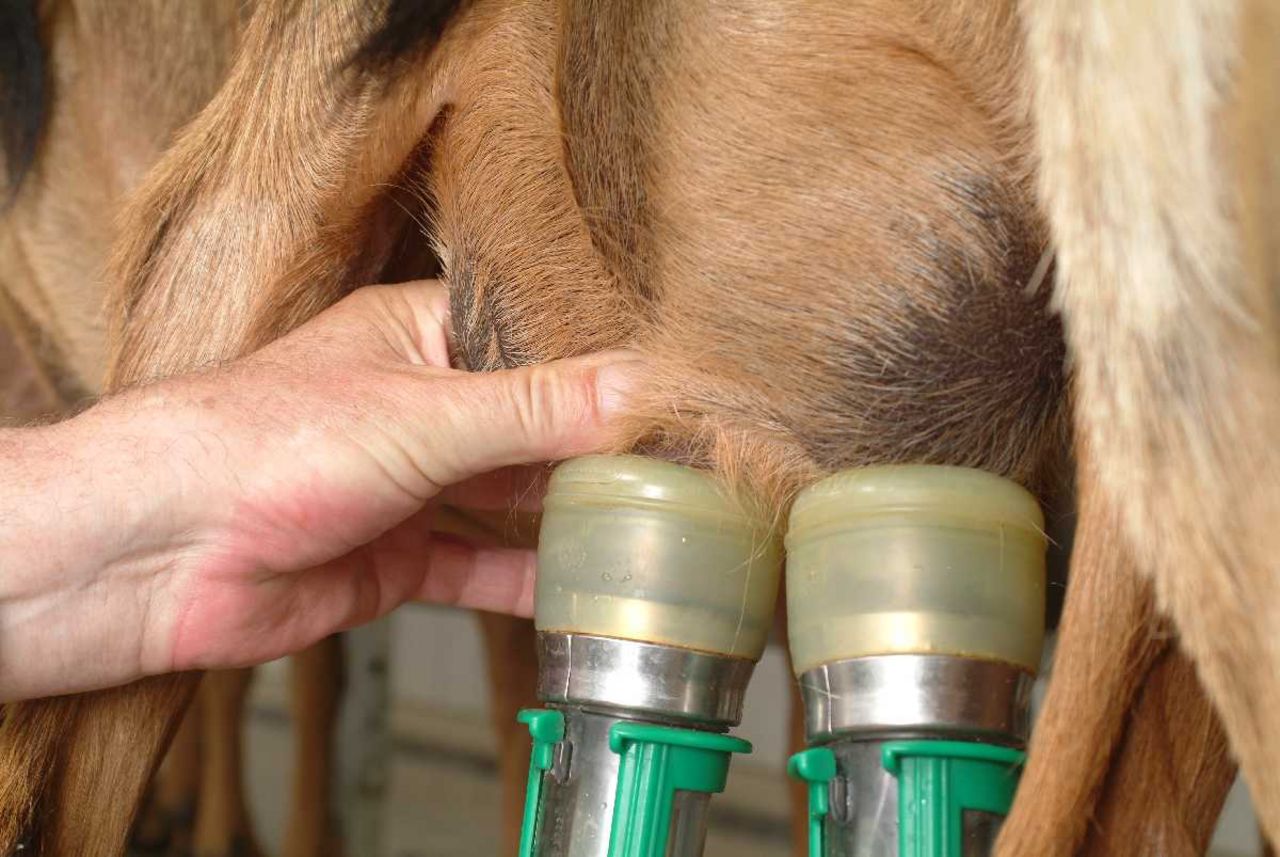Project
Evaluation of udder health of dairy goats

Monitoring of udder health as preventive tool for the improvement of udder health in dairy goats
Dairy goats suffer – like dairy cows – no rarely under udder infections, often in the subclinical form. In contrast to dairy cows, there are no proved criteria to securely assess if the udder is healthy or not.
Background and Objective
Udder infections in dairy goats were often caused by coagulase-negative Staphylococci (CNS). Subsequently, decreasing milk yields and even changings in the product quality and processing properties of the raw milk can occur.
In contrast to dairy cows the assessment of the udder health in dairy goats is problematic. Standard diagnostic methods measuring cell counts and bacteriological status cannot be used uncritical for dairy goats. While the milk of a healthy cow’s udder quarter has cell counts of maximum 100.000 cells per ml, in dairy goats 200.000 up to 1.000.000 cells per ml have been measured without an existing udder infection. This is due to a great physiological variability of the cell count. Even factors like the stage of lactation (Aulrich & Barth 2008), the number of lactation or the estrus (Barth & Aulrich 2007), which are not dependent on the infection, have an influence on the cell count in the milk of dairy goats. Regardless of these specifics some countries (like the USA or France) use already limit values of 750.000 to 1.000.000 cells per ml delivered milk.
Based on these facts, it is necessary to identify easy-to-use indicators to assess udder health in dairy goats. Those indicators serve the preservation of animal health, preventive consumer protection, and income maintenance of goat farms.
In our project we would test physiological indicators, which are influenced by udder infections: are the indicators suitable for early detection? The tested indicators were lactoferrin, lactate dehydrogenase (LDH), ß-glucuronidase, N-acetyl-ß-D-glucosaminidase (NAGase), and also the milk ingredients fat, protein and lactose.
Approach
We used the dairy goat herd of the Institute (63 animals) over a whole lactation for weekly sampling. The samples were analyzed for somatic cell count, bacteriological status, electrical conductivity, milk ingredients (fat, protein, and lactose), lactoferrin, LDH, ß-glucuronidase, and NAGase. We assessed the health status based on the results of the bacteriological analyses (“gold standard”). In bacteriologically positive samples, the pathogens were differentiated with molecular biological methods (Polymerase chain reaction (PCR)).
The influence of lactation stage, number of lactation, mean milk yield, and infection state on the indicators was tested with linear mixed models. There was no influence of the lactation stage on the indicator ß-glucuronidase. Furthermore, the indicators LDH and NAGase were not affected by the number of lactation.
There are no thresholds for the tested indicators by now. Therefore, we defined first threshold values based on the results of animals in the herd with healthy udders. Those values should be tested on their suitability to assess the state of udder health of herds in the agricultural practice. For this purpose, we took milk samples on two goat farms over three weeks. Equal analyses like the ones used for the samples from the experimental farm were conducted. The sampling on one farm took place at the beginning of the lactation while on the other farm the goats were at the end of lactation. Due to the high influence of the lactation stage on most of the indicators, we defined thresholds for the beginning and the end of the lactation. Those thresholds were used to verify the applicability of the analyzed indicators to assess the udder health status in practice.
Results
The infection rate of the herd on the experimental farm was 33.3 % and therefore complied with the one described in literature. Coagulase-negative staphylococci were the most found pathogens. On the experimental farm, S. epidermidis was the most frequently detected staphylococcus, followed by S. warneri. On the other farms the staphylococci S. simulans (farm 1) and S. aureus (farm 2) were most common.
The results of the bacteriological analyses of the milk from the animals of the experimental farm were used as a basis for further evaluations. To describe a healthy state and define thresholds for the beginning and the end of the lactation, the results of 22 healthy animals were used. The practice tests revealed that 90 % of the healthy animals could be detected as healthy at the end of lactation by using the indicators. At the beginning of lactation, only the indicator N-acetyl-ß-D-glucosaminidase was usable to detect healthy animals. Both farms had high levels of health. Therefore, only few animals were available for the comprehensive evaluation of the indicators. The ß-glucuronidase activity and the content of lactoferrin in the milk of goats turned out as interesting indicators for the assessment of udder health. They should be tested in further studies with a larger number of animals. Furthermore, it seems that different pathogens lead to various reactions on the animal and therefore to differentiated modifications of the indicator contents. Further studies are needed to gain knowledge even in this field.
Thünen-Contact

Involved Thünen-Partners
Involved external Thünen-Partners
- Max Rubner-Institut, Bundesforschungsinstitut für Ernährung und Lebensmittel (MRI)
(Karlsruhe, Hamburg, Deutschland) - Aarhus University
(Aarhus, Tjele, Dänemark)
Funding Body
-
Federal Office for Agriculture and Food (BLE)
(national, öffentlich)
Duration
11.2009 - 2.2013
More Information
Project funding number: 2808OE178
Funding program: Bundesprogramm Ökologischer Landbau und andere Formen nachhaltiger Landwirtschaft (BÖLN)
Project status:
finished
Publikationen
- 0
Aulrich K, Barth K, Stuhr T, Knappstein K, Larsen T (2013) Einfluss von Euterinfektionen auf Enzymaktivitäten in Ziegenmilch in der Frühlaktation. In: Neuhoff D, Stumm C, Ziegler S, Rahmann G, Hamm U, Köpke U (eds) Beiträge zur 12. Wissenschaftstagung Ökologischer Landbau : Ideal und Wirklichkeit: Perspektiven ökologischer Landbewirtschaftung . Berlin: Köster, pp 572-573
- 1
Stuhr T, Aulrich K, Barth K, Knappstein K, Larsen T (2013) Influence of udder infection status on milk enzyme activities and somatic cell count throughout early lactation in goats. Small Ruminant Res 111(1-3):139-146, doi:10.1016/j.smallrumres.2012.09.004
- 2
Larsen T, Aulrich K (2012) Optimizing the flourometric ß-glucuronidase assay in ruminant milk for a more precise determination of mastitis. J Dairy Res 79(1):7-15, doi:10.1017/S0022029911000720
- 3
Barth K, Aulrich K (2007) Influence of oestrus on somatic cell count in milk of goats. In: Book of Abstracts : International Symposium ; The Quality of Goat Products, 24-26 May 2007 Bella, Italy. Bella: Consiglio per la Ricerca e sperimentazione in Agricoltura - Unità di Zootecnia Estensiva, p 40
- 4
Aulrich K, Barth K (2005) Detection of coagulase-negative staphylococci in goat milk by PCR-based methods. In: Hogeveen H (ed) Mastitis in dairy production : current knowledge and future solutions ; [4th IDF International Dairy Conference]. Wageningen: Wageningen Academic Publ

![[Translate to English:] [Translate to English:]](/media/_processed_/8/e/csm_Bildschirmfoto_2021-03-03_bearb_fc48ac88bf.jpeg)
![[Translate to English:] [Translate to English:]](/media/_processed_/8/e/csm_Bildschirmfoto_2021-03-03_bearb_ba3ec0e9d7.jpeg)
![[Translate to English:] Logo des Bundesministerium für Ernährung und Landwirtschaft](/media/allgemein/logos/BMEL_Logo.svg)